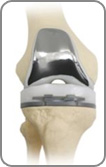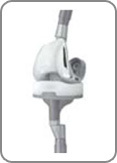| |
| Types of Implants : |
:
| |
| |
| |
Each section has an ODEP rating listed. This is an rating issued by a group of medical professionals. The number refers to the minimum number of years that the implant has been around ( 3 being a low number of years and 10 being the highest) and the letter refers to the quality of published data that supports the implant (a. being the best c. being the worst). |
| |
| Partial Knee Replacement (Uni Condular) |
|
| |
This type of treatment involves replacing just one side of the knee joint. Both the upper and lower parts of the knee are replaced, but unlike total knee replacement, just the worn out side is replaced. A metal implant is fixed (with or without bone cement) onto one of the upper side and on one side of the lower side of the knee; both of these articulate with a plastic material (polyethylene).
This is a popular type of replacement and has had good clinical results over the past 15 years with around 4,000 being implanted in the UK every year, these replacements usually last around 10 years. |
| |
| Total Knee Replacement |
| |
 Surgeons have performed total knee replacement surgery for over 40 years. Generally it is a very successful operation with over 80,000 being done every year, most total knee replacements last around 10-15 years. This surgery involves both sides of the knee joint being replaced, Both areas of bone are replaced with a metal implant and can be cemented or uncemented. These metal surfaces articulate with a piece of plastic (polyethylene) which can be fixed to the lower metal implant (tibial tray) or move on the surface of the tibial tray, the latter are known as mobile bearing knee replacements. In terms of how well they do in patients – they both perform very well. In knee replacement surgery, it is important to protect the plastic from wearing out as much as possible, as this is the weak area of the replacement. If the plastic wears out then it is likely that it will need to be replaced in the future. |
| |
| Partial Knee Replacement (Patello Femoral) |
 |
| |
This operation involves replacing some of the kneecap and the area which the knee cap moves. The area in which the kneecap (patella) moves is known as the patella groove, it is this area where a normal knee has a layer of cartilage. If this cartilage has worn out it can be painful and can be replaced with a metal surface.
A plastic (polyethylene) disc is put on the back of the kneecap and articulates with the new metal surface. This type of operation has been conducted for over 15 years but in small numbers. |
| |
| Re-do Knee (Revision Knee) |
| |
 If you have had previous knee surgery, which needs to be replaced, this is called revision surgery. A revision knee replacement is much the same as a total knee replacement. The surgeon has to remove the old implant and replace it with a new one. Once the old prosthesis is removed, there is often less bone available for fixation of the new replacement. Therefore, additional metalwork is often added to ensure a good fixation of the new implant. This extra metalwork comes in the form of metal augments, wedges, and stems. The augments and wedges are usually fixed to the new implant around the upper and lower sides of the knee to make up for any bone loss. The stems are attached to the implants themselves, if necessary, and fixed within the shaft of the thighbone or shinbone, to ensure good fixation and stability of the prosthesis. |
| |
